Hi everyone,
hopefully I'll be able to shed some light on the previously discussed XLR-RCA interfacing.
The main reason why two wires aren't enough for a high-performance audio interconnect is that no matter what you do, there will be current caused by a different ground potentials and/or a real-world interference flowing through the shield conductor. Since the shield conductor has a non-zero impedance, this current will produce a voltage and in case the shield conductor also doubles as a signal conductor, this voltage will be mixed straight into your audio.
To quote Bruno Putzeys:
The whole idea of having one of the actual signal wires also do the dirty work of shunting equalizing currents away is barmy. To then try and solve the problem by eliminating those currents is bone-headed. To try and mollycoddle the sonic defects this causes by making outlandish cables is madness. The RCA connector and all it stands for should be banned by law.
If the receiver is made differential, i.e. it only cares about the difference between the two signal conductors (XLR pins 2 and 3 or hot and cold), the "dirty work" is offloaded to shield (or XLR pin1) conductor. As long as those are not connected to the PCB on either transmitter or receiver side (which causes so called Pin1 problem) but rather diverted to the Protective Earth mains conductor, this makes for a hum-free connection.
When interfacing XLR outputs to RCA inputs, you have these options:
1) The best one from a technical standpoint: retrofitting a XLR differential input to a legacy equipment
It might be either built inside or made as an outside box with separate power. The XLR shield and pin1 would need to be grounded to the chassis on the receiving side or the whole thing might be bolted to it. A company called THAT Corporation makes very good receiver chips that would fit this task and a module using those has even been a commercially available product at some point .
https://www.neurochrome.com/that-receiver-rev-1-0/
2) A drop-in solution if you don't mind some distortion: tranformers
The transformer-based approach (like with Neutrik NA2F-DOB-TX or much more expensive Jensen transformers) will work and avoid ground loop issues. Transformers also have higher common-mode rejection ratio than what can be achieved with semiconductors. The distortion might not matter for use with tube amplifiers that already have a transformer in the signal path or with subwoofers.
3) Off the shelf XLR-RCA cables
As mentioned, these short XLR pin 3 (cold) to pin 1 (ground). That makes them work both with direct-coupled and transformer-coupled XLR inputs/outputs, but the direct-coupled ones might not be happy about the short. While the outputs of DAC8 PRO are short-circuit proof, operational amplifiers do not like huge loading and will respond with increased distortion (by several orders of magnitude).
4) Cable with floating pin3 (cold)
Using just one of the signals from the XLR side to interface with RCA is a dirty and cheap solution. We cannot guarantee this will be hum-free (depends on circumstances) or that DAC8's output will be pop-free on turn on/off in this configuration, but it is certainly a better way than the previous one. There will still be an increased distortion compared to interfacing a regular XLR input since you will be picking up the common-mode distortion products that would otherwise be rejected. Because you are only taking half of the signal, you will lose 6dB. If you still want to go that way and don't have pliers, Benchmark already makes cables like that:
https://benchmarkmedia.com/collecti...dapter-cable-pin-3-floating?variant=547761981
Is there any problems with "numbers" pairing Octo DACstereo with Denafrips Hestia pre amp ? They would be paired to tube monoblocks & speakers. Hestia has XLR in and RCA (and XLR) out for monoblocks that have just RCA in.
Denafrips Hestia specs:
https://www.denafrips.com/specs-hestia-hyperion
Thanks & cheers
They don't specify the input voltage nor the gain, but given the fact that their output works with the same voltage as DAC8 (4V RMS), I don't expect any issues.
@Okto Research
What is the latest ETA on the DAC8 PRO launch ?
When will production units be shipping ?
DAC8 PRO launch coming up in the following days! Shipping will start shortly after that. Stay tuned for the news.
Pavel, Okto Research



